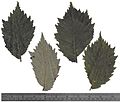Ulmus glabra 'Grandidentata'
| Ulmus glabra 'Grandidentata' | |
|---|---|
| Species | Ulmus glabra |
| Cultivar | 'Grandidentata' |
| Origin | Europe |
The Wych Elm cultivar Ulmus glabra 'Grandidentata', listed as U. glabra var. grandidentata (Moss),[1] may have been the tree first described by Dumortier in Florula Belgica, 25, 1827, as U. corylacea var. grandidentata[2] (:large-toothed hazel-like elm), in cultivation before 1830. Green thought it a synonym of 'Cornuta'.[3] 'Grandidentata' may be synonymous with U. glabra 'Corylifolia' (:hazel-leaved elm), which Green thought another synonym of 'Cornuta'.
Description[edit]
The name implies distinctively large marginal teeth, perhaps differing from the 'horns' of 'Cornuta'.
Pests and diseases[edit]
'Grandidenta' is susceptible to Dutch Elm disease.
Cultivation[edit]
No authoritatively identified specimens are known to survive.
Putative specimens[edit]
A mature open-grown large-toothed U. glabra cultivar, matching a 1903 herbarium leaf-specimen mislabelled U. montana cucullata,[4] stands in Niddrie Mains Road, Edinburgh (grafted at ground level; girth 1.4 m) (2016). The large teeth are present along the whole leaf-margin of short shoot-leaves as well as long ('Cornuta'). Though 'Cornuta'-like teeth may occur near the apex, they are rare, and do not resemble the slender 'horns' that usually appear in 'Cornuta' photographs. The tree is narrow-pyramidal, with upswept branches like a Huntingdon Elm.[5]
-
Possible 'Grandidentata', Edinburgh
-
Leaves of same
-
Dried short-shoot leaves of same (August)
-
Dried long-shoot leaves
-
Bole
Synonymy[edit]
- Ulmus corylacea var. grandidentata: Dumortier, Florula Belgica, 25, 1827 ?
- Ulmus Montana (: glabra) var. corylifolia: Zapalowicz[1], Conspectus Florae Galiciae Criticus 2: 98, 1908 ?
References[edit]
- ^ Krüssman, Gerd, Manual of Cultivated Broad-Leaved Trees & Shrubs (1984 vol. 3)
- ^ Florula Belgica, 25, 1827, Florula Belgica, 25, 1827.
- ^ Green, Peter Shaw (1964). "Registration of cultivar names in Ulmus". Arnoldia. 24 (6–8). Arnold Arboretum, Harvard University: 41–80. Retrieved 16 February 2017.
- ^ "Herbarium specimen - E00824769". Herbarium Catalogue. Royal Botanic Garden Edinburgh. Sheet described as U. montana cucullata [error for 'cornuta' (?)] (1903)
- ^ Google Maps: 260 Niddrie Mains Rd - Google Maps (July 2012), accessdate: September 4, 2016





